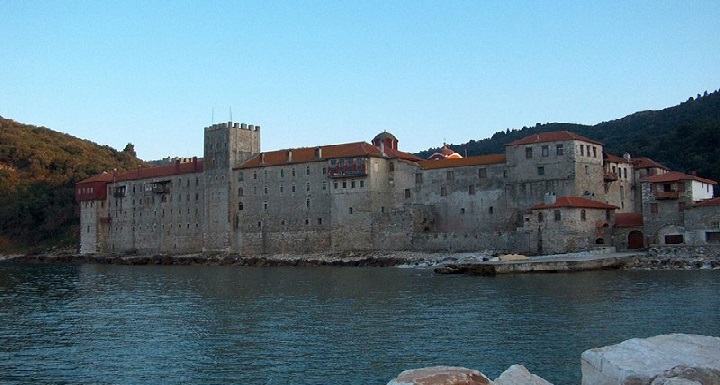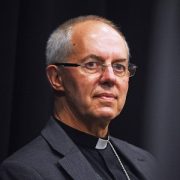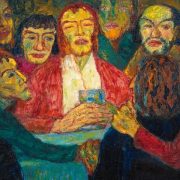
Esfigmenos Monastery
Italian version: here
Is Athos, the holy mountain of Orthodox monasticism, becoming the bridgehead of the Russian presence in the Mediterranean, a platform for the oligarchs and their trade, a breeding ground for Russian nationalism in the tsarist tradition? An article in the Bild Zeitung (May 8) raises the alarm that is bouncing in many European newspapers. The newspaper claims to be in possession of a confidential report on criminal activities of pro-Russian monks in Athos (money laundering, arms, trafficking).
One of the people quoted in the article, the igumen (superior) of the Athonite monastic community of Esfigmenos, Bartholomew, downplays and specifies the allegations he makes: he has no news of spies or financial trafficking, but notes the swelling of Russian nationalism and an unchecked space within his monastery.
The claim of tsarist power over the entire Athos area is matched by the current Russian Orthodox Church’s desire to split Greek communities, such as those in Constantinople or Cyprus, by creating new eparchies (dioceses) of Russian obedience. “What is the Greek state waiting for to wake up? For Athos to become a base for Russian ships and submarines? For the imperial dreams of the tsars to be fulfilled?” To the German weekly Spiegel, former Russian Prime Minister Spephashin (1999) confided his wish for a totally independent Athos.
The rebels of Esfigmenos
Igumen Bartholomew’s complaint concerns a building at the center of the Esfigmenos monastery that has been in the hands of dissident monks for decades, an ungovernable place, open to Russian nationalist presences (banners, sectarian organizations, Cossack nationalists, alliances with generous oligarchs, with suspicious media coverage), removed from the responsibility of both the igumen, the monastic government (Hiera Kinotis), and the jurisdiction of Constantinople.
To defend their rights they went to the civil courts all the way to the highest court in Athens, but were always rejected. The rebel monks do not canonically refer to Constantinople or even Athens, but to a schismatic Greek church that in the early 1900s opposed the change in the liturgical year to the “Julian” calendar, called the “calendarist.” Links of interest are suspected between Moscow and the schismatic “calendarists” to get the Greek Church in trouble after assenting to Ukrainian autocephaly. An out-of-control Russophile hotbed that threatens to pollute Russia’s extensive influence on the Athos Peninsula.
In addition to the monastery of Esfigmenos there is another, called “Russian,” Agios Panteleimon and a third, recently restored, Ksilurgu. The first and second belong to the twenty historic monasteries that govern the autonomous administrative unit of the peninsula (each monastery delegates a monk to the synod, within which four monks are elected who, together with a governor appointed by the Greek state, make up the Hiera Kinotis, or government). Canonical jurisdiction rests with the patriarch of Constantinople while the territory belongs to Greece, which ensures the security of the place with its police.
Anti-ecumenical
There is an old tension between monks and the Constantinopolitan patriarchate that arose in the 1960s with the initiation of ecumenical action by Athenagoras. The monks considered it a heresy.
As early as 1992 Patriarch Bartholomew censured the monks of Esfigmenos, calling them “zealots” (sectarians) and requiring them to leave the monastery. In 2003 there was an ultimatum with the intervention of the Greek police, but they did not enter the monastery because of the rules laid down in the Athos constitution.
The monks held out in a central building, while the rest of the monastery passed to the new community. Esfigmenos became the emblem not only of anti-ecumenical resistance (which is, by the way, widespread in Athos), but also of support for the Russian tradition, benefiting from the protection of the Church and Russian power. V. Putin’s visits to Athos in 2005 and 2016 are well known. In this case, in the company of Patriarch Cyril, to solemnize the millennial presence of the Russians. Speaking to the monks Cyril said, “Pray for our homeland, which today has a special responsibility, including for the preservation of Orthodoxy.
We know that the enemy of mankind is rising up against the Church today, and perhaps echoes of this difficult struggle are reaching you as well. We, in the midst of the world, are on the front lines of this struggle: and how much we need your help, your spiritual support, your remembrance in prayer, every day and every hour, for all our people, our Church and for all mankind.”
The eye of the secret service
The generous offerings of the oligarchs for the restoration of churches, monasteries and chapels on the Holy Mountain are well known. The largest investments for restoration, however, come from the Greek state and especially from European funds. Of the approximately 1,500 monks currently on Athos, about 100 are of Russian affiliation.
Together with Serbs, Bulgarians, Romanians and some Westerners they make up the diverse community of residents. The intra-Orthodox schism first (Ukrainian autocephaly) and Russia’s current aggression against Ukraine are testing internal concord and serenity. The international fight against Russian trafficking and oligarchs’ substances have rekindled intelligence attention.
Beyond the contents of the documents in Bild Zeitung’s possession, the Greek Interior Ministry has strengthened the police service by ensuring increased control over those entering and leaving Athos. An address that arose from reports about an attempt to involve some monasteries in geopolitical games far larger than the 390 square kilometers of the peninsula. Some elements were already in the hands of the intelligence services when several diplomats who had intense activity in the region were expelled from Greece in 2018.
Taboric light
Beyond the recent chronicles, Athos represents one of the most precious places of Orthodox spirituality. The Athonite ideal is the shining Christ of Tabor, the attainment of holy enlightenment in exychia (the state of stillness and silence of the Christian who has overcome turmoil and rests in God). Strict adherence to the liturgy, monastic rules, and the regulations governing the life of the holy mountain (written as early as 972 with the approval of the Byzantine emperor of the time, John Zimisce) provides the framework for a spiritual quest that has known lofty heights.
Theologians and saints such as Diadochus of Photica, Maximus the Confessor, Gregory Palamas, down to Silvanus of Mount Athos constitute an unparalleled treasure. More valuable than the landscape and architectural heritage declared a UNESCO World Heritage Site in 1980. More central than the sulfur chronicles mentioned above.





